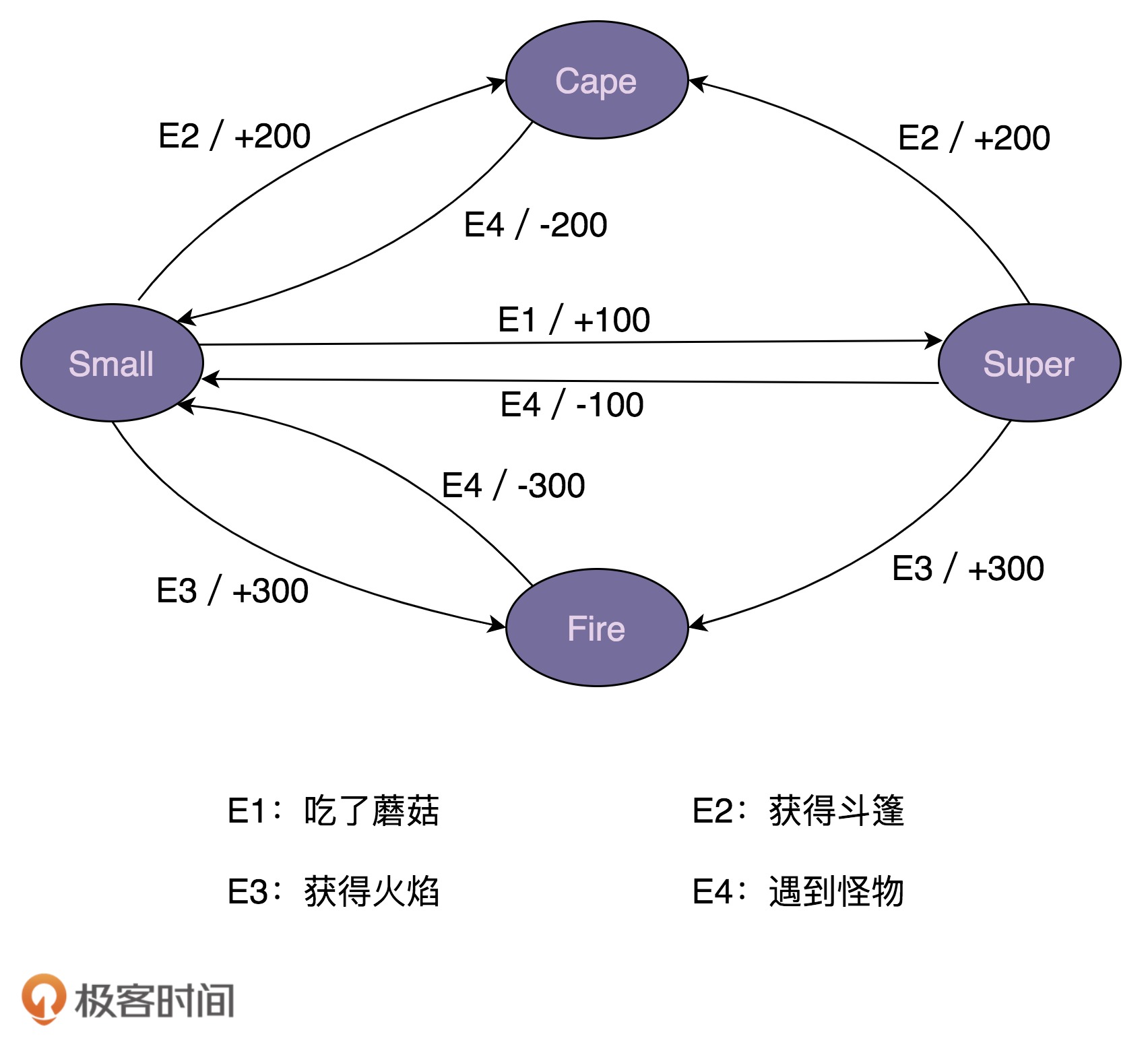定义
对有状态的对象,把复杂的“判断逻辑”提取到不同的状态对象中,允许状态对象在其内部状态发生改变时改变其行为。
结构
主要角色:
- 环境类(Context)角色:也称为上下文,它定义了客户端需要的接口,内部维护一个当前状态,并负责具体状态的切换。
- 抽象状态(State)角色:定义一个接口,用以封装环境对象中的特定状态所对应的行为,可以有一个或多个行为。
- 具体状态(Concrete State)角色:实现抽象状态所对应的行为,并且在需要的情况下进行状态切换。
结构图:
**
应用
马里奥吃蘑菇
小马里奥(Small Mario)、超级马里奥(Super Mario)、火焰马里奥(Fire Mario)、斗篷马里奥(Cape Mario
public interface IMario {State getName();void obtainMushRoom(MarioStateMachine stateMachine);void obtainCape(MarioStateMachine stateMachine);void obtainFireFlower(MarioStateMachine stateMachine);void meetMonster(MarioStateMachine stateMachine);}public class SmallMario implements IMario {private static final SmallMario instance = new SmallMario();private SmallMario() {}public static SmallMario getInstance() {return instance;}@Overridepublic State getName() {return State.SMALL;}@Overridepublic void obtainMushRoom(MarioStateMachine stateMachine) {stateMachine.setCurrentState(SuperMario.getInstance());stateMachine.setScore(stateMachine.getScore() + 100);}@Overridepublic void obtainCape(MarioStateMachine stateMachine) {stateMachine.setCurrentState(CapeMario.getInstance());stateMachine.setScore(stateMachine.getScore() + 200);}@Overridepublic void obtainFireFlower(MarioStateMachine stateMachine) {stateMachine.setCurrentState(FireMario.getInstance());stateMachine.setScore(stateMachine.getScore() + 300);}@Overridepublic void meetMonster(MarioStateMachine stateMachine) {// do nothing...}}// 省略SuperMario、CapeMario、FireMario类...public class MarioStateMachine {private int score;private IMario currentState;public MarioStateMachine() {this.score = 0;this.currentState = SmallMario.getInstance();}public void obtainMushRoom() {this.currentState.obtainMushRoom(this);}public void obtainCape() {this.currentState.obtainCape(this);}public void obtainFireFlower() {this.currentState.obtainFireFlower(this);}public void meetMonster() {this.currentState.meetMonster(this);}public int getScore() {return this.score;}public State getCurrentState() {return this.currentState.getName();}public void setScore(int score) {this.score = score;}public void setCurrentState(IMario currentState) {this.currentState = currentState;}}
利用单例
public interface IMario {State getName();void obtainMushRoom(MarioStateMachine stateMachine);void obtainCape(MarioStateMachine stateMachine);void obtainFireFlower(MarioStateMachine stateMachine);void meetMonster(MarioStateMachine stateMachine);}public class SmallMario implements IMario {private static final SmallMario instance = new SmallMario();private SmallMario() {}public static SmallMario getInstance() {return instance;}...}
优点
- 结构清晰,状态模式将与特定状态相关的行为局部化到一个状态中,并且将不同状态的行为分割开来,满足“单一职责原则”。
- 将状态转换显示化,减少对象间的相互依赖。将不同的状态引入独立的对象中会使得状态转换变得更加明确,且减少对象间的相互依赖。
状态类职责明确,有利于程序的扩展。通过定义新的子类很容易地增加新的状态和转换。
缺点
状态模式的使用必然会增加系统的类与对象的个数。
- 状态模式的结构与实现都较为复杂,如果使用不当会导致程序结构和代码的混乱。
- 状态模式对开闭原则的支持并不太好,对于可以切换状态的状态模式,增加新的状态类需要修改那些负责状态转换的源码,否则无法切换到新增状态,而且修改某个状态类的行为也需要修改对应类的源码。
扩展
有限状态机
有限状态机,英文翻译是 Finite State Machine,缩写为 FSM,简称为状态机。状态机有 3 个组成部分:状态(State)、事件(Event)、动作(Action)。其中,事件也称为转移条件(Transition Condition)。事件触发状态的转移及动作的执行。不过,动作不是必须的,也可能只转移状态,不执行任何动作。
实现方式有三种:
- 基于条件判断的最简单的实现方法
- 基于查表法的实现方法
- 基于状态模式的实现方法
由于基于状态模式的实现方法会增加类个数,增加系统复杂度,故在查表法能应付的情况下,最好使用查表法。

